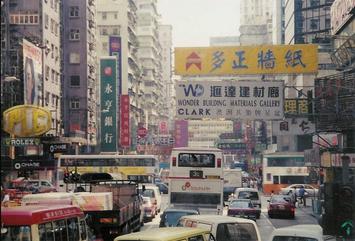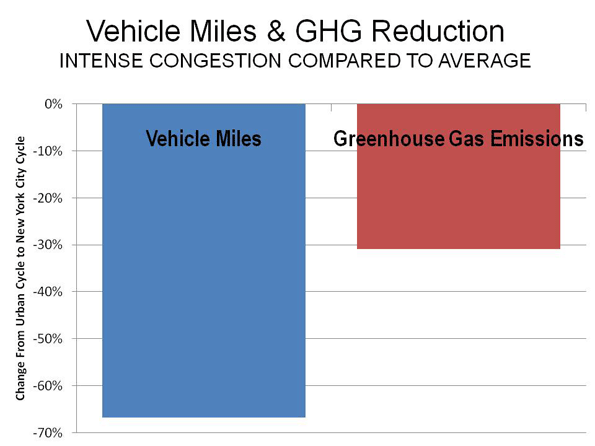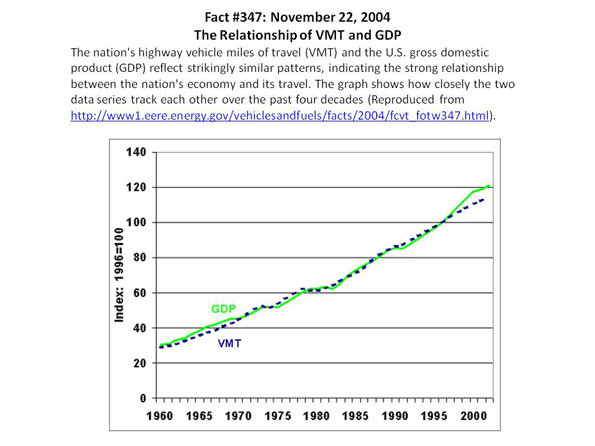
Senators Jay Rockefeller (D-West Virginia) and Frank Lautenberg (D-New Jersey) have introduced legislation that would require annual per capita reductions in driving each year. Another bill, the National Transportation Objectives Act, introduced by Representative Rush Holt (D-Indiana), Representative Russ Carnahan (D-Missouri) and Representative Jay Inslee (D-Washington.) would require a 16 percent reduction in driving in 20 years.
Last week, a highly publicized report by the Urban Land Institute (Moving Cooler) also called for policies that would reduce the vehicle miles traveled (VMT) by people in their cars. This report was analyzed here by Alan Pisarski). The reductions in driving would be achieved by highly intrusive land use policies that would make it impossible for most Americans to live where they want, allow for only minor expansion of roadway capacity and force almost all new development to be within existing urban footprints. It would employ such radical strategies as forcing people to pay $400 per year to park their cars in front of their own homes.
The assumption behind these initiatives is that reducing driving will produce substantial reductions in greenhouse gas emissions. It sounds like a simple enough proposition, since cars emit greenhouse gases in direct proportion to the gasoline they consume. It would seem logical that reducing their use would lower their emissions by a similar percentage. Moving Cooler assumes that for every 10 percent reduction in driving miles, there will be a 9 percent reduction in greenhouse gas emissions.
Meager GHG Emission Reductions from Reducing Driving: But things are not nearly so simple. It appears that reducing vehicle miles would not produce a similar reduction in greenhouse gases from cars.
It is well known that at the slower speeds of vehicle operation in cities, fuel economy tends to decline with speed. Further, as congestion increases, so does fuel consumption, due to longer idling periods (such as at signals or in stopped traffic), more acceleration and more deceleration. Thus, not only does fuel economy drop when average speeds drop, but it drops even further when traffic congestion intensifies. The extent to which any reduction in urban driving would reduce greenhouse gas emissions is not at all well known, simply because there has been insufficient research on the subject.
Perhaps the best indication is a comparison of Environmental Protection Agency (EPA) “driving cycles,” which are tests used to estimate some emissions (although not greenhouse gases) and fuel economy. There is considerable data for the normal urban cycle, which replicates driving conditions in most of the nation’s urban areas. There is much less information available for the “New York City Cycle,” which replicates the congested traffic conditions in New York City, which is far more congested than any of the nation’s urban areas (Note).
Under the New York City Cycle average speeds are two-thirds less than under the average urban cycle. This reduction in speed and increase in congestion results in a 50 percent loss in fuel economy, according to an Argonne National Laboratory Study. Thus, between New York City and the average urban area, fuel efficiency drops at a rate 80 percent of the lower driving rate in New York City.
On average, vehicle travel in New York City is approximately 8 miles per capita daily. In the average large urban area outside New York City (such as the Phoenix urban area, or for that matter the suburbs of New York City), vehicle travel is approximately 24 miles per day per capita. Thus, per capita driving in New York City is 67 percent less than in Phoenix. However, because of the loss in fuel consumption, the greenhouse gas emissions from cars per capita is only 31 percent less (Figure 1). Thus, the limited data indicates that nearly one-half of the greenhouse gas emissions difference between New York City driving rates and Phoenix driving rates are cancelled out by the impacts of slower speeds and increased congestion.

Shortcomings of Policies to Reduce Driving: UCLA’s Lewis Center for Regional Policy Studies Program on Local Government Climate Action Policies raised concerns about relying on VMT reduction policies in a submittal to the California Air Resources Board:
Especially in congested areas of California, VMT is an inadequate proxy for vehicle greenhouse gas emissions.
Yet it is precisely more intense traffic congestion that we can expect if federal laws and policies should force most development into present urban footprints. Between 2010 and 2030, nearly 70,000,000 residents will be added to US urban areas, an increase of more than 25 percent. This increase would mean that the legislation introduced by Congressmen Hold, Carnahan and Inslee would require a one-third reduction in per capita driving to achieve its overall 16 percent reduction. Per capita driving declines such as those envisioned by the Congressmen or Moving Cooler have never occurred before in any American (or international) urban area. By comparison, charging people $400 to park their cars in front of their houses seems utterly reasonable.
Further, higher population densities are associated with more intense traffic, both at the national and international level. Policies such as recommended by Moving Cooler would produce little additional highway capacity to handle the far higher levels of driving produced by a larger population. We could expect traffic congestion to increase markedly. It would take longer to get to work and local air pollution would be more intense (a health impact largely ignored by proponents of higher densities).
The Economic Cost: A serious economic toll would be produced by more grid-locked urban areas, because of the positive relationship between personal mobility and economic performance. Remy Prud’homme and Chang-Woon Lee of the University of Paris have shown that greater economic mobility is associated with greater economic growth. Greater personal mobility also alleviates poverty, according to a Progressive Policy Institute study):
In most cases, the shortest distance between a poor person and a job is along a line driven in a car. Prosperity in America has always been strongly related to mobility and poor people work hard for access to opportunities. For both the rural and inner-city poor, access means being able to reach the prosperous suburbs of our booming metropolitan economies, and mobility means having the private automobile necessary for the trip. The most important response to the policy challenge of job access for those leaving welfare is the continued and expanded use of cars by low-income workers.
The UCLA submission further notes that policies aimed at reducing driving could damage the economy:
… policies which seek to reduce VMT may hinder economic growth without reducing emissions.
The relationship between greater mobility and economic prosperity is also demonstrated at the national level. This is vividly illustrated in the chart from the United States Department of Energy (Figure 2).

The significant improvements in fuel economy from higher mileage cars and less carbon intensive fuels will do far more to reduce greenhouse gas emissions from cars than the meager results that can be achieved by heavy handed policies to “coerce” people out of their cars (as Secretary of Transportation Ray LaHood put it). And, critically, it would do so with far less impact on both economic and physical mobility.
Both the Economy and Greenhouse Gas Emissions at Stake: With the economic challenges facing the nation, policy makers need to steer clear of strategies that hobble the economy, like forcing people to drive less (or pay $400 to park in front of their houses) and make only minor improvements in reducing emissions. Indeed, a society with less money will have less to spend on reducing emissions through the adoption of new technologies that offer greater hope for creating a more prosperous as well as more environmentally sustainable society.
Note: The New York City refers to the City of New York, not the metropolitan area or the urban area.
Wendell Cox is a Visiting Professor, Conservatoire National des Arts et Metiers, Paris. He was born in Los Angeles and was appointed to three terms on the Los Angeles County Transportation Commission by Mayor Tom Bradley. He is the author of “War on the Dream: How Anti-Sprawl Policy Threatens the Quality of Life.”













better post
Thank you, I've been seeking for info about this subject matter for ages and yours is the best I have discovered so far.
first american home buyers protection corporation
home warranty company reviews
Gas Emission
Gas emission becoming the problem for people that creating several bad issues in atmosphere. Slower the vehicle operation it creates problem for people which must be stopped as soon as possible. The green house effect creating so much problem for people that is happening due to the increasing number of vehicle in society and the carbon emission from them. I think this problem can only be solved after adopting the electric vehicle otherwise by inserting the smoke filtering part in vehicle. Mercedes Auto Parts Apple Valley
Vehicle reduction is the
Vehicle reduction is the best idea to reduce pollution that ultimately reduces the green house gas emission. But it is not the solution, due to the hike in number of vehicle on road it leading a lots of atmospheric effective gasses in air. It is creating problem for you. I must say that better to use the rental car so that one car would have share by number of people that may decrease the number of vehicle on road. The solution rise in using the electric vehicle rather than the fuel vehicles. Otherwise you may also include one smoke emission pipe in vehicle that will stop reaching the poisonous gasses in air. If you are interested to insert the part in your vehicle then better to visit Saab Repair Johns Creek, GA and do it.
This is an excellent step
This is an excellent step taken for the bright future of the state. This encourages job growth and challenges ahead. Reducing vehicles is the finest decision taken by the government as it will feeble the emission green hose gas which is good sign of pollution free states. This problem is generally faced in the urban areas. Hope this may solve the trafficking issues. Porsche Repair Chatsworth
change for visually impaired
change for visually impaired readers? Would you simply eliminate references to illustrations or attempt to describe them.
Buy High PageRank BackLinks
Driving reduction that reduce vehicle emisson
Basically in big countries we have found multiple ways in pollution increases; most probably vehicles are completely responsible for increasing pollution. So in order to reduce the initial stage of pollution increase we should be more conscious on pollution control; through reducing the use of fuel vehicles we are able to put a control over vehicle emission or pollution increasing problems.
Audi Repair Irvine
Vehicle Servicing
In city areas you can find the percentage of vehicle is more and for that people are facing problem of hot and so many diseases. Green house effect is the headache that is increasing due to the more number of vehicle as well as due to the emission problem in vehicle. Sometimes people used to ignore their servicing time and suffers from emission problem in vehicle that hampers the atmosphere increases the green house effective gas in air. I would like to suggest that better to do the servicing of your car in proper time at any of the best servicing center.
Beverly Hills BMW service
Vehicle miles
Especially in urban sector we have found millions of vehicles. No doubt it ultimately helps to increase the percentage of air pollution and also affects the traffic condition of the country. So day by day we have found a certain increase in the use of fuels that is used in vehicle; therefore vehicle manufacturing companies are using gas in their vehicles to reduce pollution; that is arise due to vehicles smokes.
BMW repair Centennial, CO
Vehicle emissions
Especially in urban countries we have found the increasing number of vehicles; that ultimately contribute towards the pollution level of the country. Therefore every government authority tries to overcome from the dangerous issues of pollution and for that; they used to take beneficial steps that includes "Go Green" concepts. Under "Go Green" term we are able to put a control over the increasing level of pollution in the country.
BMW brake repair Addison, TX
great post
excellent. one of the best articles I have every read. This is the information which I have been searching. Great information. Ecopolitan EC | Ecopolitan EC price | Ecopolitan | Ecopolitan Punggol | Ecopolitan Executive Condo | Sea Horizon | Sea Horizon EC | Sea Horizon Executive Condo | Sea Horizon Executive Condominium | Sea Horizon Pasir Ris | Sea Horizon EC price | Tembusu Condo | Tembusu at Kovan | Tembusu Kovan | Tembusu condo Price | Tembusu | Vue 8 residence | Vue 8 residence price | Vue 8 Condo | Vue 8 Pasir Ris | Vue 8 | the inflora | inflora condo | inflora loyang | inflora this article is worth bookmarking. keep it up !